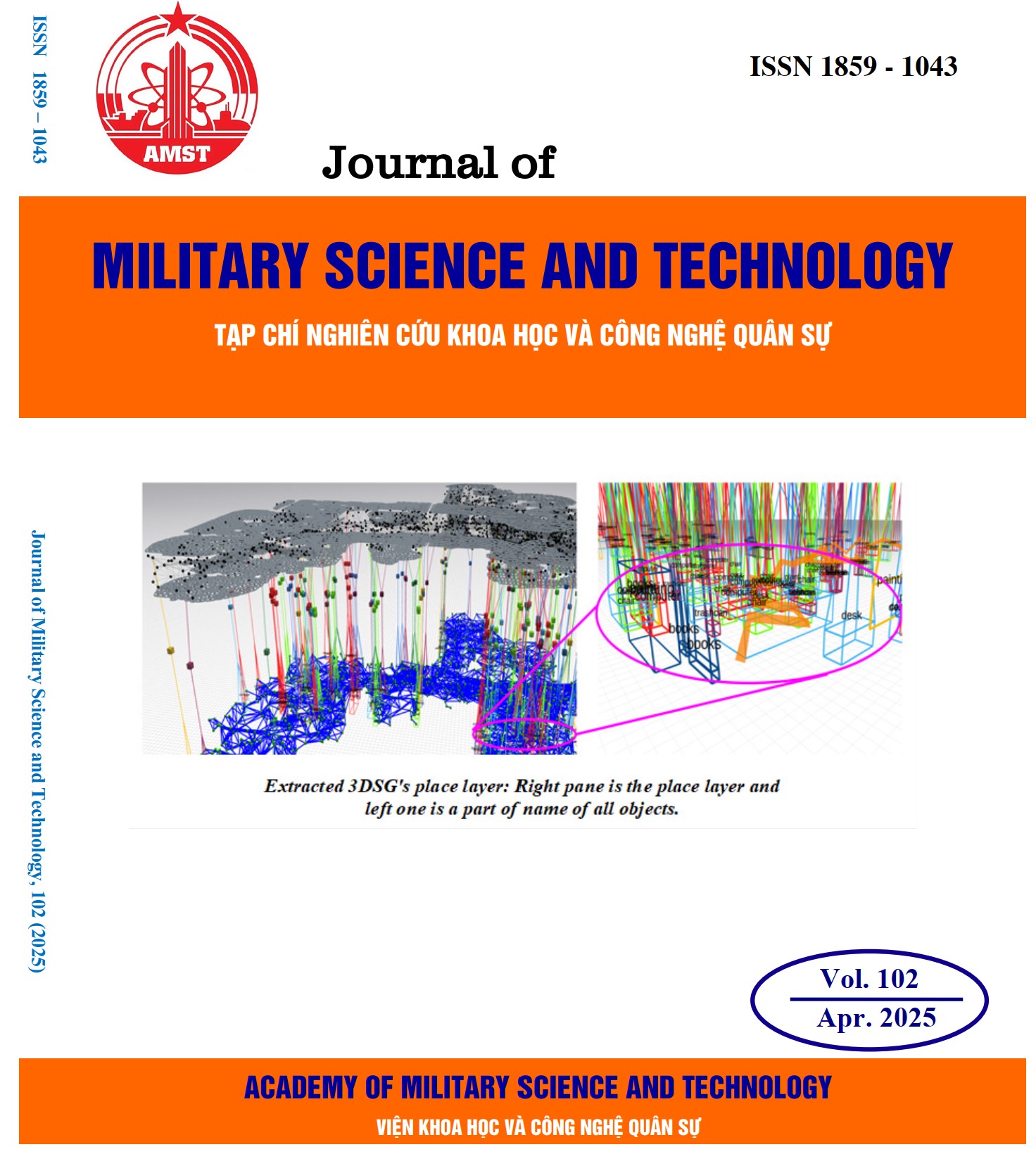Cobalt-doped biochar derived from coir fiber activation for peroxymonosulfate degradation of methylene blue
572 viewsDOI:
https://doi.org/10.54939/1859-1043.j.mst.102.2025.76-83Keywords:
Biochar; Dye; PMS activation; Cobalt; Biomass.Abstract
In this work, metal-impregnated biochar (Co-Biochar) was used to activate peroxymonosulfate (PMS) and degrade methylene blue (MB) in aqueous solutions. This procedure illustrates a possible method for transforming garbage into useful commodities. Coconut fiber was pyrolyzed in an inert environment to produce biochar, which was then modified with metal salts using the co-precipitation technique. The structural features of the resultant material were studied using sophisticated analytical methods such as scanning electron microscopy (SEM), energy-dispersive X-ray spectroscopy (EDS), and nitrogen adsorption-desorption isotherms. Following PMS activation, the catalyst degraded MB with remarkable efficiency. More than 90% of the MB was removed within 15 minutes using optimum conditions (0.05 g of catalyst, 100 mL of 50 mg/L MB solution, and 400 mg/L PMS). Additionally, the effects of various reaction parameters, such as catalyst dosage, PMS concentration, solution pH, and reaction temperature, were investigated. The findings suggest that Co-Biochar holds significant potential as a PMS activator for the treatment of MB in textile wastewater.
References
[1]. H. Ouasif et al., "Removal of a cationic dye from wastewater by adsorption onto natural adsorbents", Journal of Materials and Environmental Science, Vol.4, 1-10, (2013).
[2]. H. M. Solayman et al., "Performance evaluation of dye wastewater treatment technologies: A review", Journal of Environmental Chemical Engineering, Vol.11, 3, 109610, (2023). DOI: https://doi.org/10.1016/j.jece.2023.109610
[3]. K. Piaskowski et al., "Dye Removal from Water and Wastewater Using Various Physical, Chemical, and Biological Processes", AOAC Int, Vol.101, 5, 1371-1384, (2018). DOI: https://doi.org/10.5740/jaoacint.18-0051
[4]. Y. M. Sgibnev et al., "A comparative study of photocatalytic activity of Na+–Ag+ ion-exchanged glass-ceramics with metallic Ag, semiconductor AgBr, and hybrid Ag–AgBr nanoparticles", Dalton Transactions, Vol.52, 36, 12661-12667, (2023). DOI: https://doi.org/10.1039/D3DT01712E
[5]. K. Sathishkumar et al., "Electrochemical decolorization of methyl red by RuO(2)-IrO(2)-TiO(2) electrode and biodegradation with Pseudomonas stutzeri MN1 and Acinetobacter baumannii MN3: An integrated approach", Chemosphere, Vol.183, 204-211, (2017). DOI: https://doi.org/10.1016/j.chemosphere.2017.05.087
[6]. S. K. M. Nzaba et al., "Comparative study of visible-light active BiOI and N,Pd-TiO2 photocatalysts: Catalytic ozonation for dye degradation", Colloids and Surfaces A: Physicochemical and Engineering Aspects, Vol.684, (2024). DOI: https://doi.org/10.1016/j.colsurfa.2024.133167
[7]. H. Kumari et al., "A review on photocatalysis used for wastewater treatment: dye degradation", Water, Air, Soil Pollution, Vol.234, 6, 349, (2023). DOI: https://doi.org/10.1007/s11270-023-06359-9
[8]. R. Tanveer et al., "Integration of physical and advanced oxidation processes for treatment and reuse of textile dye-bath effluents with minimum area footprint", Journal of Cleaner Production, Vol.383, 135366, (2023). DOI: https://doi.org/10.1016/j.jclepro.2022.135366
[9]. X. Pang et al., "LaCoO3 perovskite oxide activation of peroxymonosulfate for aqueous 2-phenyl-5-sulfobenzimidazole degradation: Effect of synthetic method and the reaction mechanism", Chemical Engineering Journal, Vol.304, 897-907, (2016). DOI: https://doi.org/10.1016/j.cej.2016.07.027
[10]. B.-T. Zhang et al., "Sulfate radical and its application in decontamination technologies", Critical Reviews in Environmental Science Technology, Vol.45, 16, 1756-1800, (2015). DOI: https://doi.org/10.1080/10643389.2014.970681
[11]. D. Zhou et al., "Sulfur‐replaced Fenton systems: can sulfate radical substitute hydroxyl radical for advanced oxidation technologies?", Journal of Chemical Technology Biotechnology, Vol.90, 5, 775-779, (2015). DOI: https://doi.org/10.1002/jctb.4525
[12]. F. Ghanbari et al., "Application of peroxymonosulfate and its activation methods for degradation of environmental organic pollutants: Review", Chemical Engineering Journal, Vol.310, 41-62, (2017). DOI: https://doi.org/10.1016/j.cej.2016.10.064
[13]. G. P. Anipsitakis et al., "Radical generation by the interaction of transition metals with common oxidants", Vol.38, 13, 3705-3712, (2004). DOI: https://doi.org/10.1021/es035121o
[14]. B. Bayatsarmadi et al., "Recent Advances in Atomic Metal Doping of Carbon-based Nanomaterials for Energy Conversion", Small, Vol.13, 21 (2017), DOI: https://doi.org/10.1002/smll.201700191
[15]. S. Xiao et al., "Iron-mediated activation of persulfate and peroxymonosulfate in both homogeneous and heterogeneous ways: a review", Vol.384, 123265, (2020). DOI: https://doi.org/10.1016/j.cej.2019.123265
[16]. M. T. Yang et al., "Cobalt-impregnated biochar produced from CO(2)-mediated pyrolysis of Co/lignin as an enhanced catalyst for activating peroxymonosulfate to degrade acetaminophen", Chemosphere, Vol.226, 924-933, (2019). DOI: https://doi.org/10.1016/j.chemosphere.2019.04.004
[17]. J. Liu et al., "Peroxymonosulfate activation by cobalt particles embedded into biochar for levofloxacin degradation: Efficiency, stability, and mechanism", Separation and Purification Technology, Vol.294, (2022). DOI: https://doi.org/10.1016/j.seppur.2022.121082
[18]. V. T. Nguyen et al., "Cobalt-impregnated biochar (Co-SCG) for heterogeneous activation of peroxymonosulfate for removal of tetracycline in water", Bioresour Technol, Vol.292, (2019), 121954. DOI: https://doi.org/10.1016/j.biortech.2019.121954
[19]. J. Wang et al., "Preparation, modification and environmental application of biochar: A review", Vol.227, 1002-1022, (2019). DOI: https://doi.org/10.1016/j.jclepro.2019.04.282
[20]. D. V. Cử, "Vị thế cây dừa Việt Nam," Sở khoa học và Công nghệ Bến Tre (2024), Available: http://dost-bentre.gov.vn/tin-tuc/3257/vi-the-cay-dua-viet-nam (in Vietnamese).
[21]. S. F. Guarnieri et al., "Coconut fiber biochar alters physical and chemical properties in sandy soils", Acta Scientiarum. Agronomy, Vol.43, (2021), DOI: https://doi.org/10.4025/actasciagron.v43i1.51801
[22]. Y. Lee et al., "Comparison of biochar properties from biomass residues produced by slow pyrolysis at 500 degrees C", Bioresour Technol, Vol.148, 196-201, (2013). DOI: https://doi.org/10.1016/j.biortech.2013.08.135
[23]. J. I. Hedges et al., "The molecularly-uncharacterized component of nonliving organic matter in natural environments", Vol.31, 10, 945-958, (2000). DOI: https://doi.org/10.1016/S0146-6380(00)00096-6
[24]. K. A. Spokas, "Review of the stability of biochar in soils: predictability of O: C molar ratios", (2010). DOI: https://doi.org/10.4155/cmt.10.32







